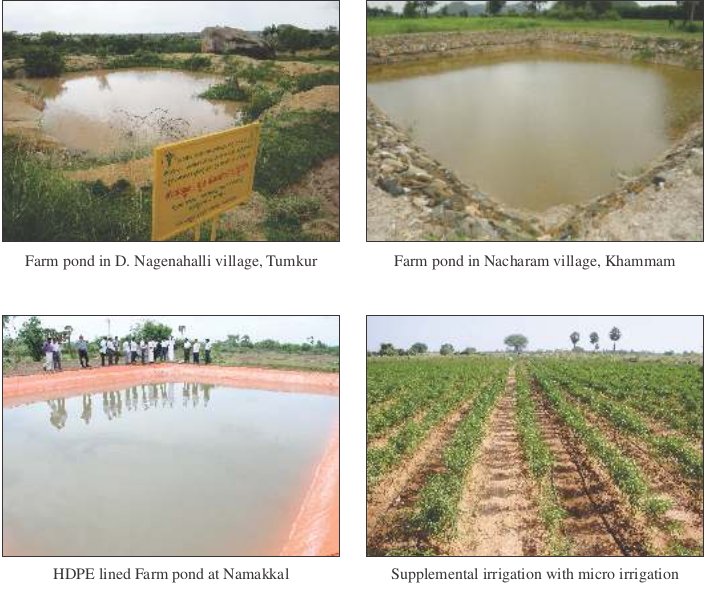Individual farm ponds for improving livelihoods of small farmers
Individual farm ponds for improving livelihoods of small farmers
Climate vulnerability
Drought
Existing practice
Across the tropics, smallholder farmers face numerous risks in agricultural production. Rainfall is erratic and inadequate, and the crops are mostly dependent on monsoon. Climatic variability is expected to disproportionately affect smallholder farmers and make their livelihoods even more precarious. Small scale water harvesting structures at individual farm level enable reuse of harvested water during critical periods of growth stage or for providing pre-sowing irrigation to rabi crop. Various models of small scale water harvesting systems have been promoted by governmental and nongovernmental organizations involving different farm pond sizes, lining material, reuse of harvested water for different crops at critical crop growth stages.
Resilient practice / technology
One way to cope with climate vulnerability is to collect rainwater in harvesting structures to increase the irrigated areas as well as crop productivity. Farm ponds have been considered as one of the key interventions in NICRA villages and have been widely adopted in the villages. Various cropping system modules were worked out by using harvested water. Majority of farmers opted to cultivate vegetables with harvested water in a ratio of 1:10 (command to catchment area) with sustained profits.
Impact of individual farm ponds
Examples of successful interventions where harvested rainwater was efficiently used for crop production.
| Village | KVK/ District | No. | Storage capacity (cu.m) | No. of farmers covered | Protective irrigation potential created (ha) | Increase In cropping intensity (%) |
|---|---|---|---|---|---|---|
| Kukurha | Buxar | 1 | 1800 | 06 | 1.75 | 100 |
| Affaur | Saran | 2 | 11500 | 42 | 10 | 25 |
| Chopanadih | Koderma | 1 | 16560 | 50 | 20 | 40 |
| Takli | Amravati | 2 | 8400 | 25 | 10 | 20 |
| Nacharam | Khammam | 4 | 1460 | 4 | 9.6 | 40 |
| Sanora | Datia | 3 | 9500 | 10 | 19 | 100 |
| Nagenhalli | Tumkur | 73 | 68100 | 77 | 65 | 100 |
Major observations
- Increased irrigation area in the villages
- Increase in crop productivity
- Farmers with farm pond took up at least two assured crops in a year
- Shift to vegetable cultivation is one strong indicator
- Increase in ground water level
| Village | KVK/ District | Technology Demonstrated | Crop | Area (ha) | Net Return (Rs) | Benefit : Cost ratio |
|---|---|---|---|---|---|---|
| Lagga | Chamba | Sprinkler | Cauliflower | 2 | 380165 | 3.9 |
| Kukurha | Buxar | LEWA | Rice | 4 | 27285 | 2.0 |
| Affaur | Saran | Micro irrigation | Long gourd | 2 | 65988 | 3.0 |
| Takli | Amravati | Sprinkler | Cotton | 10 | 36300 | 2.5 |
| Nacharam | Khammam | Drip | Chilli | 2 | 9000 | 2.0 |
| Nidhan | Morena | Sprinkler | Wheat | 8 | 52200 | 2.6 |
| Vadavathur | Namakkal | Sprinkler | Onion | 35 | 215565 | 3.2 |
| Nagenahalli | Tumkur | Drip | Brinjal | 2 | 102500 | 3.7 |
| Nagenahalli | Tumkur | Sprinkler | Grount nut | 1 | 59500 | 3.3 |
Sri Venkatappa is one such farmer in the D.Nagenahalli village of Tumkur district, Karnataka owns one acre of dryland with low soil fertility. He used to grow ragi crop only during the monsoon. The yield of the crop used to be less due to delayed monsoon and uneven rainfall. The NICRA team from KVK, Hirehalli proposed suitable interventions in his small farm. The leveled land was made into compartments to reduce soil erosion.
One farm pond of dimension 20 m x 20 m x 2 m with water storage capacity of 800 m3 was dugout to harvest runoff water. He now takes three crops in a year with the help of farm pond. He grows tomato, chilies and coriander in one acre. During the first year even though monsoon was not good he still managed to get sufficient yield. It was possible only due to the farm pond. He cultivated tomato in 0.25 ha area which gave an yield of 7 tonnes and an additional income of Rs 28000. He cultivated chilies in 0.25 ha which gave an yield of 1500 kg of green chilies and an additional income of Rs 20000. He also cultivated coriander in 0.25 ha area which gave an yield of 800 kg and an additional income of Rs 16000. Sri Venkatappa earlier could grow a single crop of ragi for family consumption. With a small farm pond, he could now cultivate high value crops.

Scope for upscaling
Farm ponds can be up-scaled in the rainfed districts of Aurangabad, Nawada, Saran, Cooch Behar, Chatra, Port blair, Supaul, Mokokchung, Chitrakoot, Kushinagar, Amravati, Anantapur, Aurangabad, Kurnool, Nalgonda, Khammam, Pune, Kota, Rajkot, Bilaspur, Dantewada, Datia, Ganjam, Kendrapara, Morena, Chikkballapur, Davangere, Tumkur, Nagapattinam, Namakkal and Ramanathapuram.
Source: Smart practices and Technologies for Climate Resilient Agriculture
Last Modified : 3/1/2020
This topic provides information about Captive rear...
This topic provides information about Check dams f...
This topic provides information about Crop diversi...
This topic provides information about Community ta...
